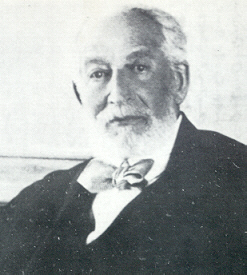
Baron Abraham Edmond Benjamin James de Rothschild was a French member of the Rothschild banking family. A strong supporter of Zionism, his large donations lent significant support to the movement during its early years, which helped lead to the establishment of the State of Israel – where he is simply known as "The Baron Rothschild", "HaBaron", or "Hanadiv".

Waddesdon Manor is a country house in the village of Waddesdon, in Buckinghamshire, England. Owned by National Trust and managed by the Rothschild Foundation, it is one of the National Trust's most visited properties, with over 463,000 visitors in 2019.

Eythrope is a hamlet and country house in the parish of Waddesdon, in Buckinghamshire, England. It is located to the south east of the main village of Waddesdon. It was bought in the 1870s by a branch of the Rothschild family, and belongs to them to this day.

Ascott House, sometimes referred to as simply Ascott, is a Grade II* listed building in the hamlet of Ascott near Wing in Buckinghamshire, England. It is set in a 32-acre / 13 hectare estate.

Mentmore is a village and civil parish in the Aylesbury Vale district of Buckinghamshire, England. It is about three miles east of Wingrave, three miles south east of Wing.

Mentmore Towers, historically known simply as "Mentmore", is a 19th-century English country house built between 1852 and 1854 for the Rothschild family in the village of Mentmore in Buckinghamshire. Sir Joseph Paxton and his son-in-law, George Henry Stokes, designed the building in the 19th-century revival of late 16th and early 17th-century Elizabethan and Jacobean styles called Jacobethan. The house was designed for the banker and collector of fine art Baron Mayer de Rothschild as a country home, and as a display case for his collection of fine art. The mansion has been described as one of the greatest houses of the Victorian era. Mentmore was inherited by Hannah Primrose, Countess of Rosebery, née Rothschild, and owned by her descendants, the Earls of Rosebery.
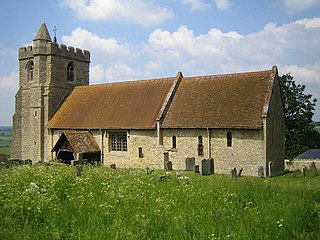
Upper Winchendon or Over Winchendon is a village and civil parish in the Aylesbury Vale District of Buckinghamshire, England. It is about 1.5 miles (2.4 km) south of Waddesdon and 4.5 miles (7 km) west of Aylesbury. A mid-air collision on 17 November 2017 between a plane and a helicopter just outside the village was referred to by much of the press as the "Waddesdon Manor air incident".

Nathaniel Charles Jacob Rothschild, 4th Baron Rothschild,, is a British peer, investment banker and a member of the Rothschild banking family.

Baron Ferdinand de Rothschild, also known as Ferdinand James Anselm Freiherr von Rothschild, was a British Jewish banker, art collector and politician who was a member of the prominent Rothschild family of bankers. He identified as a Liberal, later Liberal Unionist, and sat as a Member of Parliament in the House of Commons from 1885 to 1898. Ferdinand had a younger sister, Alice, who like her brother was a keen horticulturalist and collector. She inherited Ferdinand's property, Waddesdon Manor, in 1898 after he died and likewise continued the tradition of using the house as a place to keep his impressive collections.

An aviary is a large enclosure for confining birds, although bats may also be considered for display. Unlike birdcages, aviaries allow birds a larger living space where they can fly; hence, aviaries are also sometimes known as flight cages. Aviaries often contain plants and shrubbery to simulate a natural environment.

Sir David Frank Adjaye is a Ghanaian-British architect. He is known for having designed many notable buildings around the world, including the National Museum of African American History and Culture in Washington, D.C. Adjaye was knighted in the 2017 New Year Honours for services to architecture. He is the recipient of the 2021 Royal Gold Medal, making him the first African recipient and one of the youngest recipients. He was made a member of the Order of Merit in 2022.
The Rothschild banking family of England was founded in (1798) by Nathan Mayer von Rothschild (1777–1836) who first settled in Manchester but then moved to London. Nathan was sent there from his home in Frankfurt by his father, Mayer Amschel Rothschild (1744–1812). Wanting his sons to succeed on their own and to expand the family business across Europe, Mayer Amschel Rothschild had his eldest son remain in Frankfurt, while his four other sons were sent to different European cities to establish a financial institution to invest in business and provide banking services. Nathan Mayer von Rothschild, the third son, first established a textile jobbing business in Manchester and from there went on to establish N M Rothschild & Sons bank in London.

Alice Charlotte von Rothschild, otherwise referred to as 'Miss Alice', was a socialite and member of the Rothschild banking family of Austria. Born in Frankfurt, she was the eighth and youngest child of Anselm von Rothschild (1803–1874) and Charlotte Rothschild (1807–1859) and younger sister of the British politician, Baron Ferdinand de Rothschild. She was quite young when her family moved to Vienna, where her father took over the management of the family-owned S M von Rothschild bank.

Anselm Salomon von Rothschild, baron was an Austrian banker, founder of the Creditanstalt, and a member of the Vienna branch of the Rothschild family.
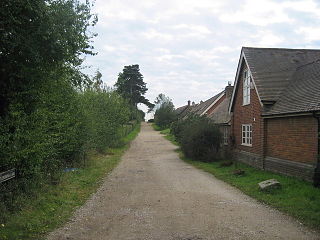
Hastoe is a hamlet in the civil parish of Tring. It is located in the Chiltern Hills, 1.7m south of the town of Tring in the county of Hertfordshire and on the county boundary with Buckinghamshire.

Waddesdon Road railway station, called Waddesdon railway station before 1922, was a small halt in open countryside in Buckinghamshire, England. It was opened in 1871 as part of a short horse-drawn tramway to assist with the transport of goods from and around the Duke of Buckingham's extensive estates in Buckinghamshire and to connect the Duke's estates to the Aylesbury and Buckingham Railway at Quainton Road. In 1872 the line was expanded and converted for passenger use, becoming known as the Brill Tramway. In 1899 the operation of the line was taken over by the London-based Metropolitan Railway.
Bruce Beaton St Clair Munro is a dual nationality English/Australian artist known for producing large immersive site-specific installations, often by massing components in the thousands. Frequently, Munro’s subject matter is his own experience of fleeting moments of rapport with the world and existence in its largest sense, of being part of life’s essential pattern. His reoccurring motif is the use of light on an environmental scale in order to create an emotional response for the viewer.
Michael Hue-Williams is a British art dealer and gallery director. He currently lives and works in London, and owns Albion Barn gallery in Oxfordshire.
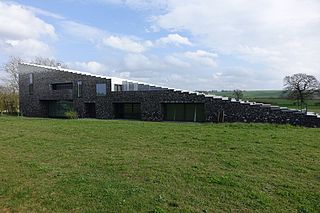
Flint House is a domestic dwelling on the Waddesdon Estate, Buckinghamshire, England. It was commissioned by Jacob Rothschild, 4th Baron Rothschild, and completed in 2015, winning that year's RIBA House of the Year Award. The architect was Charlotte Skene Catling, a partner of Skene Catling de la Peña. The stones for the exterior were hand-knapped by master flint knappers John Lord and Simon Williams in Norfolk. The interiors were decorated and furnished by David Mlinaric, using an eclectic mix of modern contemporary pieces and older items from the Rothschild collection. The ethos of the house is that it blends and harmonises with the surrounding landscape and environment.
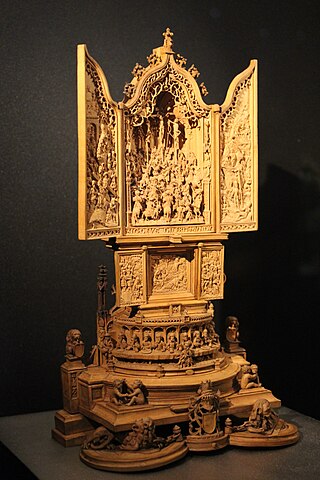
The miniature altarpiece in the British Museum, London, is a very small portable Gothic boxwood miniature sculpture completed in 1511 by the Northern Netherlands master sometimes identified as Adam Dircksz, and members of his workshop. At 25.1 cm (9.9 in) high, it is built from a series of architectural layers or registers, which culminate at an upper triptych, whose center panel contains a minutely detailed and intricate Crucifixion scene filled with multitudes of figures in relief. Its outer wings show Christ Carrying the Cross on the left, and the Resurrection on the right.

















